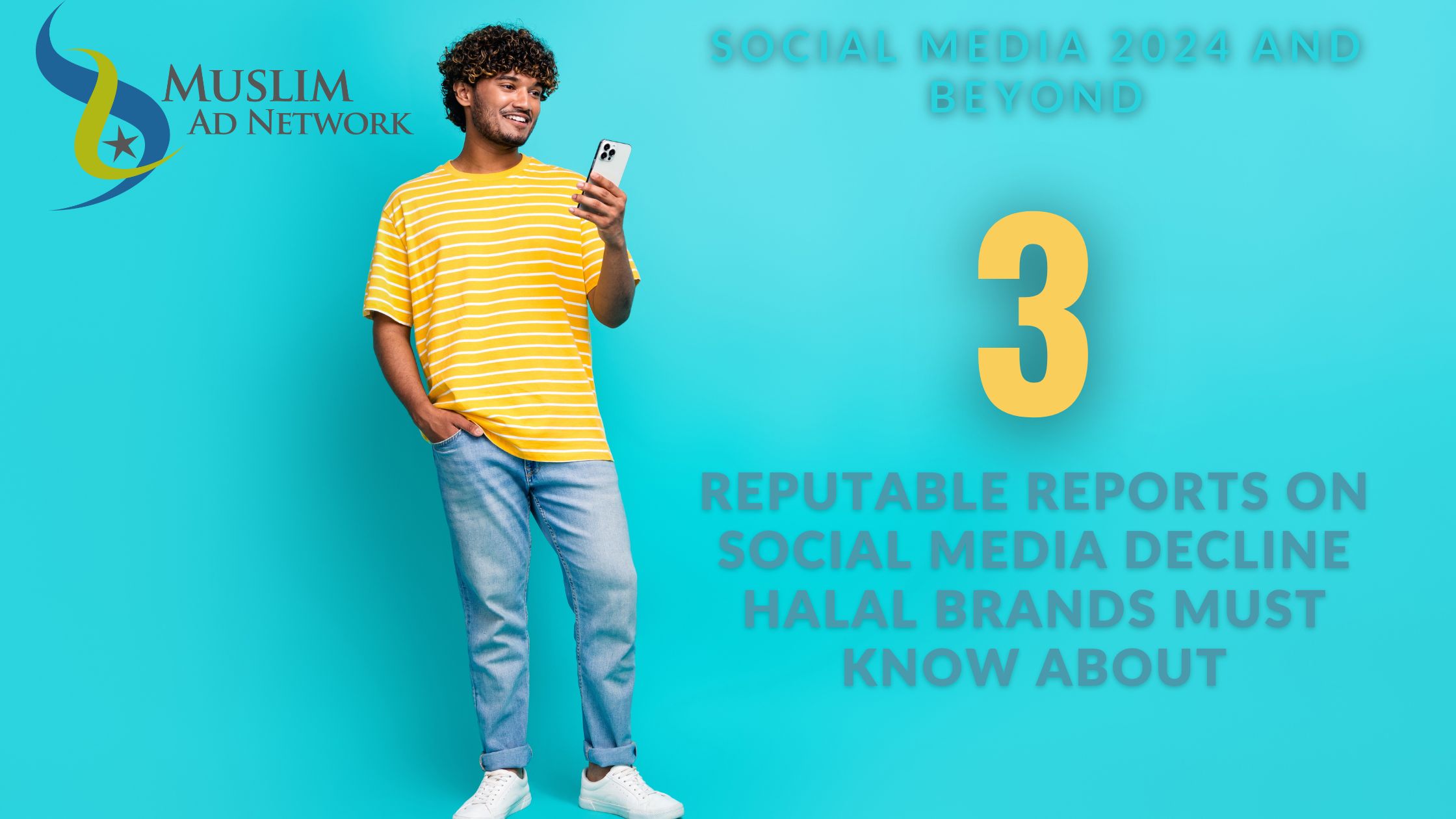
Teenage Social Media Preferences in 2023
In an ever-changing digital landscape, insights from a recent Pew Research report titled “Teens, Social Media and Technology 2023” shed light on the current trends among U.S. teenagers aged 13 to 17. Despite ongoing concerns about the impact of social media on the younger generation, the report highlights the sustained popularity of platforms such as YouTube, TikTok, Snapchat, and Instagram. With around nine in ten teens using YouTube and significant engagement on TikTok, Snapchat, and Instagram, these platforms continue to shape the digital experiences of the younger demographic.
The report delves into the dynamics of social media use, revealing interesting patterns across demographics. The decline of Facebook and Twitter among teens compared to a decade ago emphasizes the dynamic nature of the social media landscape.
It’s vital for brands, especially those in the halal sector, to acknowledge and adapt to the significant changes happening, especially with the booming youth population in the Islamic world. To succeed, your halal brand should strive to connect with the changing preferences of the younger Muslim audience and strategically position itself on the most engaging platforms.
In this blog post, we explore the future of social media opportunities for halal brands, drawing inspiration from the latest report from Pew Research, Gartner, and Insider Intelligence. By comprehending the current social media landscape and anticipating future trends, halal brands can effectively engage with their target audience and leverage the vast potential offered by these digital platforms.
Also read: Is Your Halal Advertising Ready for Gen Alpha? and 5 Surprising Gen Z Social Media Attitudes Halal Brands Must Know About
Abandoning Social Media by 2025
Insights from a recent survey conducted by Gartner, a prominent market research firm, indicate a substantial change in consumer behavior. Anticipations suggest that by 2025, 50% of consumers will either scale back significantly or completely abandon their interactions with social media. Captured in the study titled “Gartner Predicts 50% of Consumers Will Significantly Limit Their Interactions with Social Media by 2025,” this shift is linked to consumers’ perceptions of declining quality across these platforms.
According to the survey, 53% of consumers believe that the current state of social media has deteriorated compared to the previous year or the past five years. The primary reasons cited for this perceived decline include the proliferation of misinformation, toxic user bases, and the prevalence of bots. Moreover, over 7 in 10 consumers express concerns about the impact of the anticipated use of Generative AI in social media, fearing that it will harm the overall user experience.
Emily Weiss, Senior Principal Researcher at Gartner, notes that despite social media remaining a top investment channel for digital marketing, consumers are actively seeking to limit their use. A significant portion of respondents mentioned sharing less of their own lives and content on these platforms compared to a few years ago. In response to these changing dynamics, Weiss emphasizes the need for Chief Marketing Officers (CMOs) to recalibrate their customer acquisition and loyalty retention strategies.
The survey also sheds light on the widespread mistrust and lack of confidence in AI’s capabilities, with 72% of consumers expressing concerns that AI-based content generators could spread false or misleading information. In response to this, a subset of brands is expected to shy away from AI, prioritizing a more human positioning in what Gartner terms the “acoustic” concept. This approach aims to distance brands from perceptions of AI-powered businesses as impersonal and homogeneous.
As the use of Generative AI becomes more prevalent, Gartner predicts a significant shift in brands’ organic search traffic, foreseeing a decrease of 50% or more by 2028. However, consumers are ready for AI-enhanced search, with 79% of respondents expecting to use it within the next year. Moreover, 70% of consumers express at least some level of trust in Generative AI-backed search results.
Strategic Insights for Halal Advertisers
Advertisers are confronting a transformative shift characterized by being “less social and more media,” as outlined in a report from Insider Intelligence titled “Exploring the Evolution of Social Media and Its Implications for Advertisers.” Rather than indicating a decline, this evolution reflects a change in user behavior. Users are engaging in less frequent posting, influenced by carefully curated influencer campaigns and algorithm-driven feeds that heighten the significance of each post.
According to analyst Debra Aho Williamson, although users are posting less frequently, their time spent on platforms like TikTok and Instagram is increasing. The allure of checking feeds, watching stories, engaging in DMs, and consuming short videos remains robust, particularly among the Gen Z demographic. However, the emphasis has shifted from content creation to active consumption, with stories gaining prominence as a format offering a lower-pressure alternative to traditional posts.
While influencers and content creators maintain a consistent public presence, most users have transitioned into avid consumers, spending more time in DMs and stories. Adam Mosseri, Head of Instagram, notes that teens, in particular, allocate more time to DMs and stories than traditional in-feed content.
In response to posting fatigue, tech companies have introduced new platforms such as Threads, Lemon8, and BeReal. However, these initiatives have struggled to retain users, highlighting the challenge of revitalizing public posting.
Despite these shifts, advertisers have ample opportunities to leverage the evolving social media landscape. With users estimated to spend an average of 1 hour and 47 minutes on social platforms, strategies must align with changing user behaviors:
- Stories Still Stand Out: Stories, with their ephemeral nature, provide a less pressurized environment for both viewing and posting. Advertisers can make the most of this by incorporating paid ads in Stories and collaborating with influencers for Story content.
- In-Feed Ads Remain Relevant: Although users are posting less, time spent scrolling through in-feed content on platforms like Instagram and TikTok has increased. Advertisers should continue investing in in-feed ads and influencer collaborations to reach their audience effectively.
- Embracing Niche Communities: Advertisers can explore niche communities as traditional posting wanes. While not as accessible as public posts, these communities can yield significant returns. Brands can initiate their communities through strategically crafted hashtags, fostering a sense of belonging among their audience.
Actionable Points for Your Halal Brand’s Social Media
Based on the information provided in this article, here are some actionable points for your halal brand to navigate the evolving landscape of social media:
Prioritize Engagement on Popular Platforms
Focus on YouTube, TikTok, Snapchat, and Instagram: Since these platforms are highly popular among teenagers, allocate resources and efforts to create engaging content on these platforms.
Anticipate the Potential Decline in Social Media Use
Prepare for Changing Consumer Behavior: Acknowledge the possibility of a decline in social media use by 2025. Diversify your digital marketing strategies to include other channels and methods of reaching your audience.
Address Consumer Concerns About Social Media Quality
Emphasize Transparency and Quality: Mitigate concerns about declining social media quality by ensuring transparency in your brand communication. Provide high-quality content and actively address any misinformation related to your brand.
Navigate AI Skepticism in Social Media
Humanize Your Brand: Considering consumer mistrust in AI, adopt a more human approach to your branding. Highlight the personal and authentic aspects of your halal brand to create a connection with your audience.
Strategic Use of Generative AI
Evaluate the Impact of Generative AI: Stay informed about the potential impact of Generative AI on organic search traffic. Be prepared to adapt your digital marketing strategy accordingly.
Optimize Content for Changing User Behavior:
Leverage Stories and In-Feed Ads: Given the shift towards more active consumption and less frequent posting, invest in stories on platforms like Instagram and consider in-feed ads on platforms where users spend increased time scrolling.
Engage with Influencers and Content Creators:
Collaborate with Influencers: Since influencers maintain a consistent public presence, collaborate with them for authentic and engaging content that resonates with your target audience.
Explore Niche Communities
Create Branded Communities: Initiate and engage with niche communities relevant to your halal brand. Use strategically crafted hashtags to foster a sense of belonging among your audience.
Adapt to User Preferences
Stay Agile and Adaptive: Continuously monitor social media trends and be ready to adapt your strategy based on the preferences of the younger Muslim audience. Experiment with different content formats to see what resonates the most.
Invest in Paid Ads
Allocate Budget for Paid Ads: Given the evolving landscape, consider allocating a portion of your marketing budget to paid ads on stories, ensuring your brand stays visible and engaging.
By incorporating these actionable points into your social media strategy, your halal brand can effectively navigate the changing landscape and connect with the younger Muslim audience on platforms they frequent. Keep an eye on emerging trends and be ready to adjust your approach to remain relevant in the ever-evolving world of social media.
start targeting muslim consumers